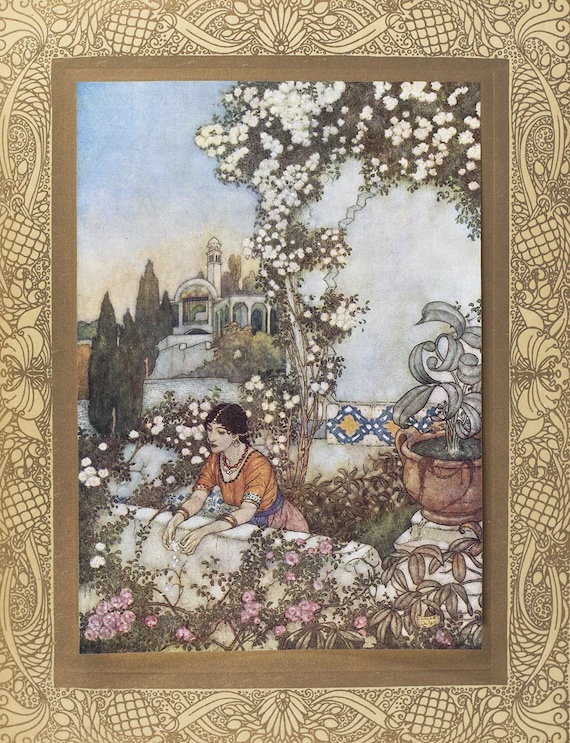Stanza 18 in the first edition of Edward FitzGerald’s The Rubáiyát of Omar Khayyám is the last in the series that emphasizes the impermanence of royal glory and it transitions to a subsequent set of meditations on the transitory character of life itself
XVIII.
- I sometimes think that never blows so red
The Rose as where some buried Cæsar bled ;
That every Hyacinth the Garden wears
Dropt in its Lap from some once lovely Head.
This stanza is no. 43 from the Bodleian manuscript:
هر جا که گلی و لاله زاری بودست
از سرخیِ خونِ شهریاری بودست
هر برگِ بنفشه کز زمین میروئید
خالیست که بر رخِ نگاری بودست
FitzGerald’s version hews pretty close to the original Persian. Of course in the first two lines the reference is to a generic “king” shahriyārī in Persian, rather than specifically to the Roman ‘Caesar.”
Still, interestingly enough, the term “Caesar” was taken into Arabic even before Islam and appeared, since some Arab tribes in what is now Jordan were auxiliaries of the Roman cavalry.
When the Ottomans took Constantinople in 1453, Sultan Mehmet II took the title “Caesar of Rome” (qaysar-e Rum) in addition to sultan. So thereafter there is a sense in which the Ottomans saw themselves as the successors of the Caesars, who had a millennium before consecrated Constantinople as their new capital in 330 CE.
The great dictionary of Dehkhoda notes that “In Persian literature, some poets have used ‘qaysar’ [Caesar] as a symbol of power and glory.”
In an ode for Shah Shoja’ (r. 1358 – 1384) of the Muzaffarid dynasty in post-Mongol Iran, Hafez of Shiraz wrote that no one could make himself equal to the Iranian king, saying:
“In another year, they’ll bring you tribute from your Caesar in Rome
and from your China they’ll bring to court the tribute of their souls.”
سال دگر ز قیصرت از روم باج سر
وز چینت آورند به درگه خراج جان
After the first great Indian rebellion of 1857-1858 was put down by the British Empire, the state took over rule of the subcontinent from the East India Company and controlled it directly. In consequence, Queen Victoria became the direct sovereign of India, and she styled herself “Qaysar-e Hend” in Persian, “the Caesar of India.”
So FitzGerald’s use of “Caesar” for shahriyārī was an attempt to naturalize the poetry for Westerners, but readers of Persian would have recognized the trope to which he appealed.
In my no. 42 in The Rubaiyat of Omar Khayyam: A New Translation from the Persian I translated the second two lines this way:
and every violet takes its color from
a beauty mark on a slain sweetheart’s cheek.
The flower in the original is the banafsheh or violet, not the hyacinth.
The word for “beauty mark” here is literally “mole” or khāl.
—-
Order Juan Cole’s contemporary poetic translation of the Rubáiyát from
or Barnes and Noble.
or for $16 at Amazon Kindle
——-
The mole was considered a great sign of beauty, and generated a famous anecdote about Hafez. He wrote,
اگر آن ترک شیرازی به دست آرد دل ما را
به خال هندویش بخشم سمرقند و بخارا را
If that Shirazi Turk would take my heart in hand
I’d give all of Samarqand and Bukhara for her Indian mole.
It is said that later on when Hafez met the Central Asian conqueror Tamerlane, the monarch rebuked him for assigning so little worth to the great cities of his realm.

Illustration for the Rubaiyat by Edmund Dulac, 1909. H/t Wikimedia.
Turkic women in Shiraz were nobility because Turkish tribes were conquerors after the Mongols declined. They were famed for not veiling, and so their beauty was celebrated by Persian poets.
The mole is not called “Indian” really but “Hindu,” and so an analogy may be being made to the decorative dot or bindi that Hindu women wear as a cosmetic. If that was the reference, it would help explain why the poetry attributed to Omar Khayyam identifies the mole with the violet flower, and sees violets as having pushed up from deceased stunners’ beauty marks. It is in some ways a creepy image worthy of a horror movie, and many of the Khayyami poetry’s observations about death are reminiscent of Edgar Allen Poe in their lugubriousness.
—-
For more commentaries on FitzGerald’s translations of the Rubáiyát, see
FitzGerald’s Rubáiyát of Omar Khayyám: Commentary by Juan Cole with Original Persian


 © 2025 All Rights Reserved
© 2025 All Rights Reserved